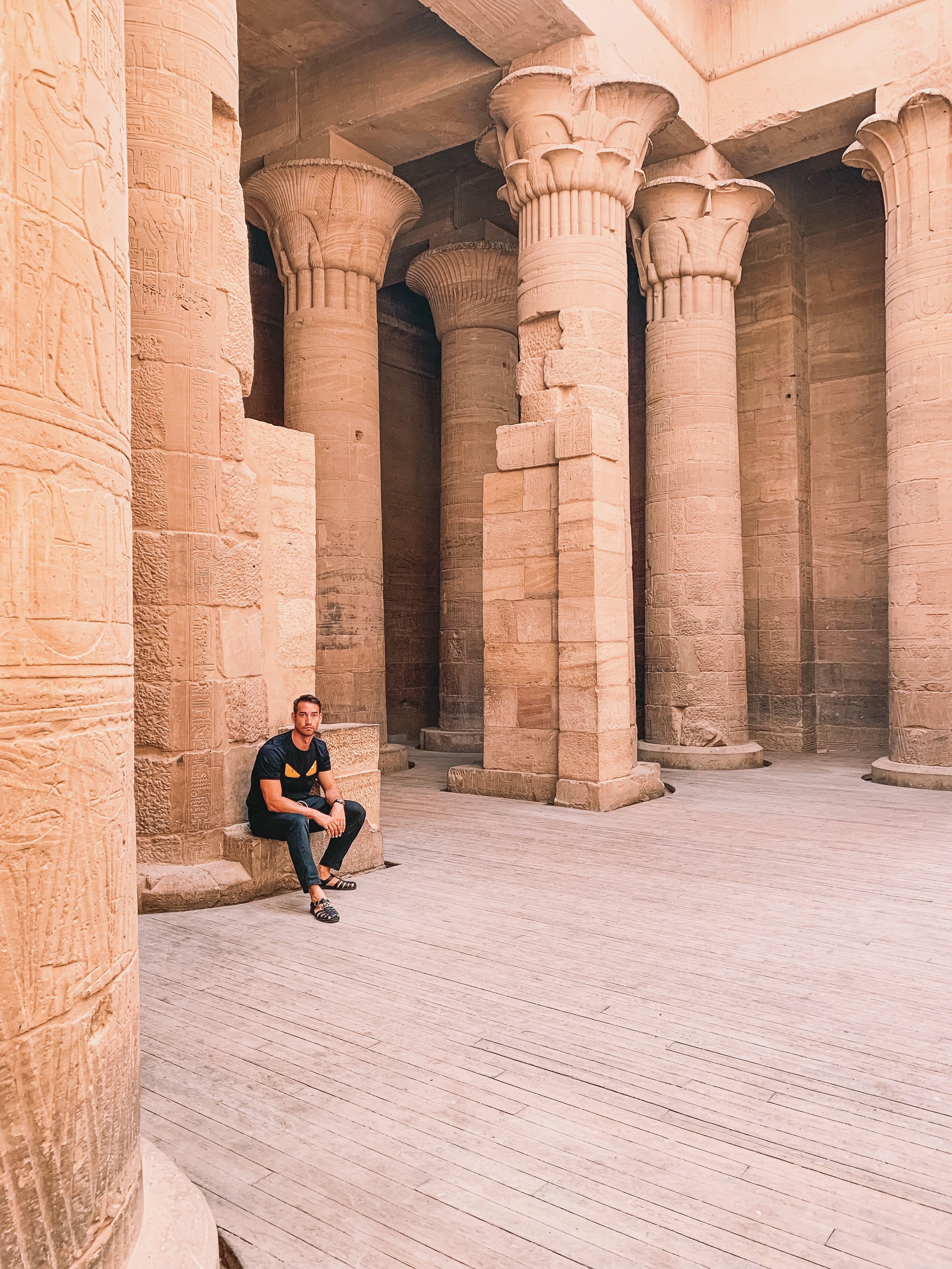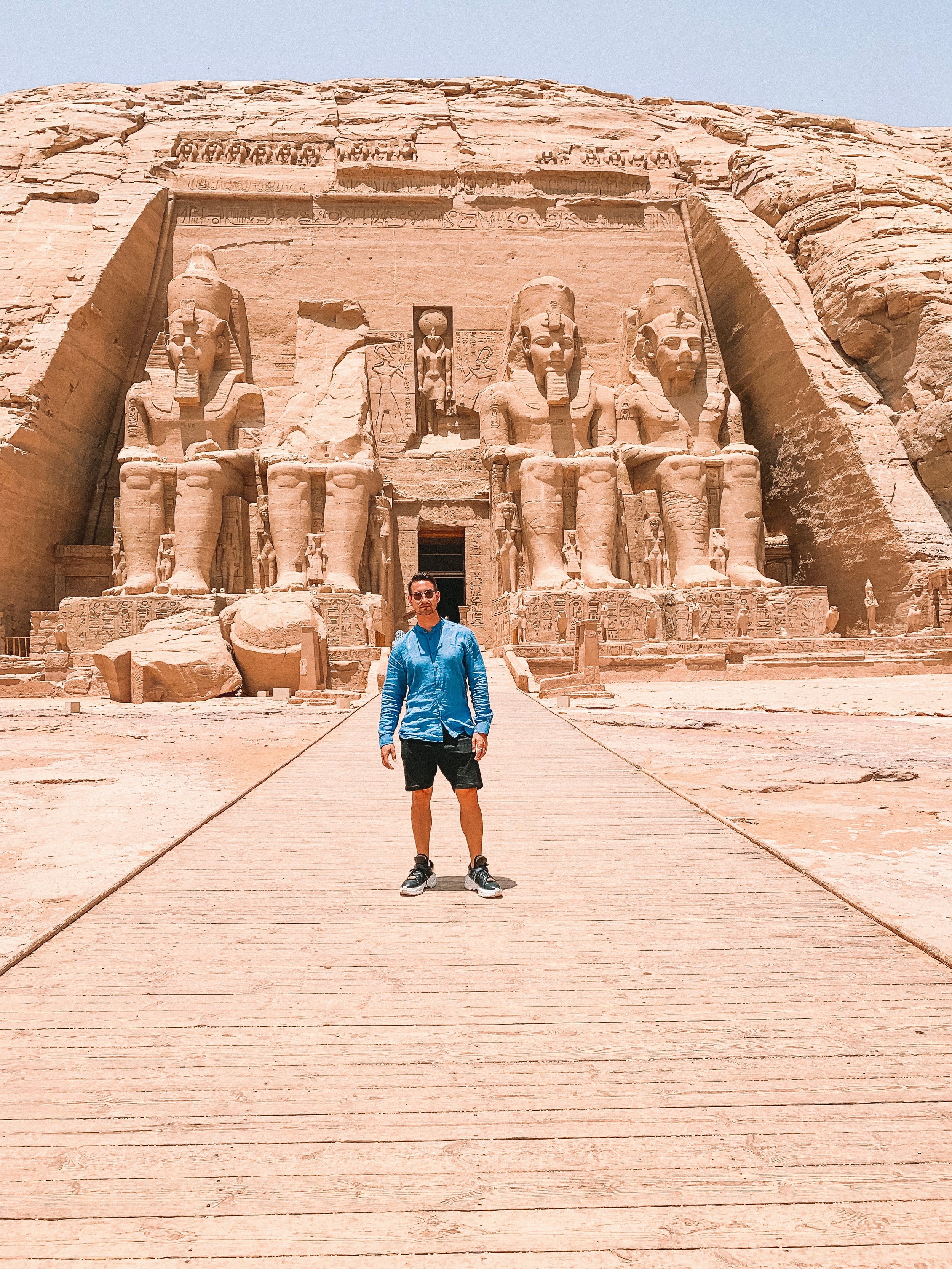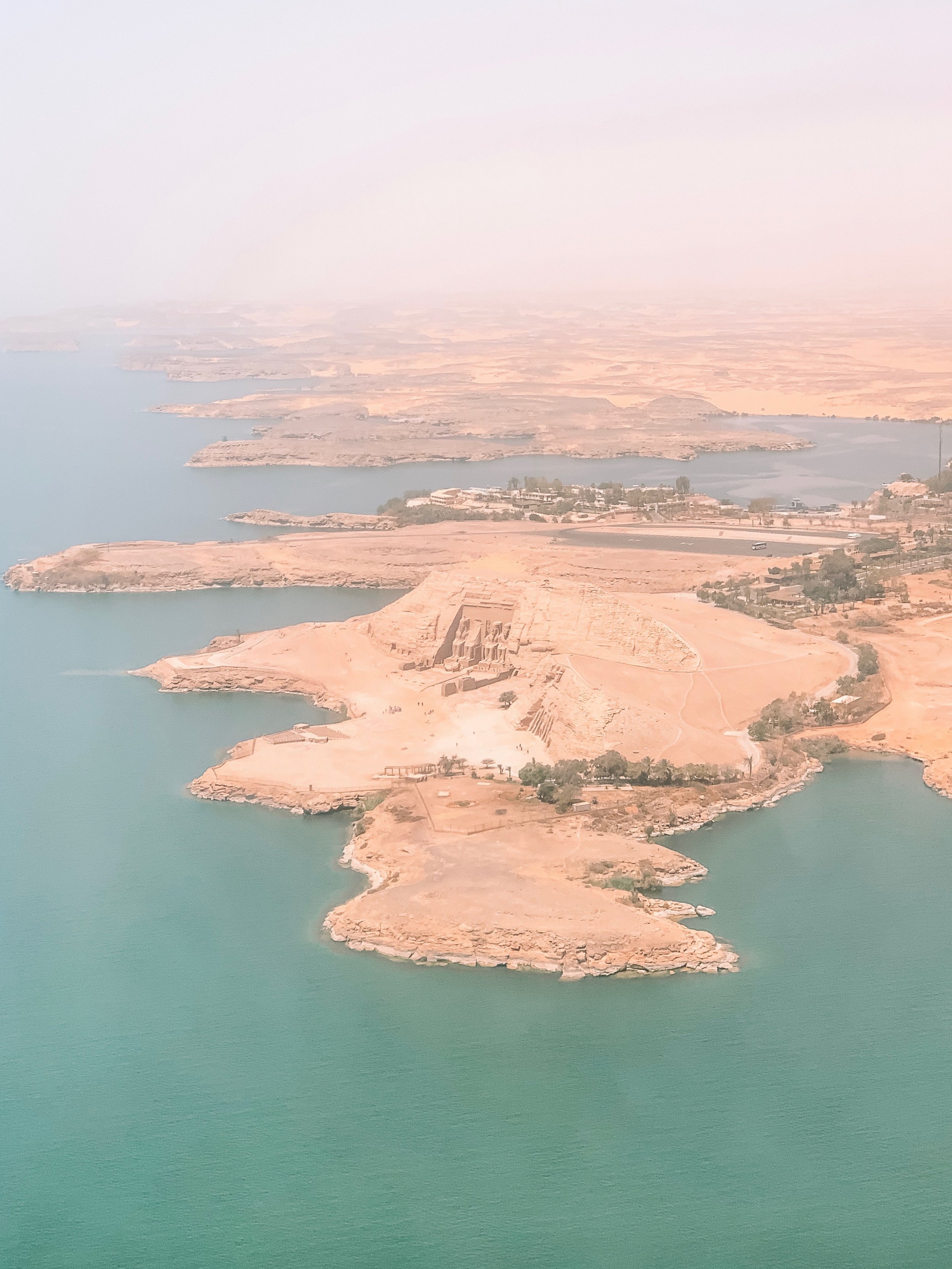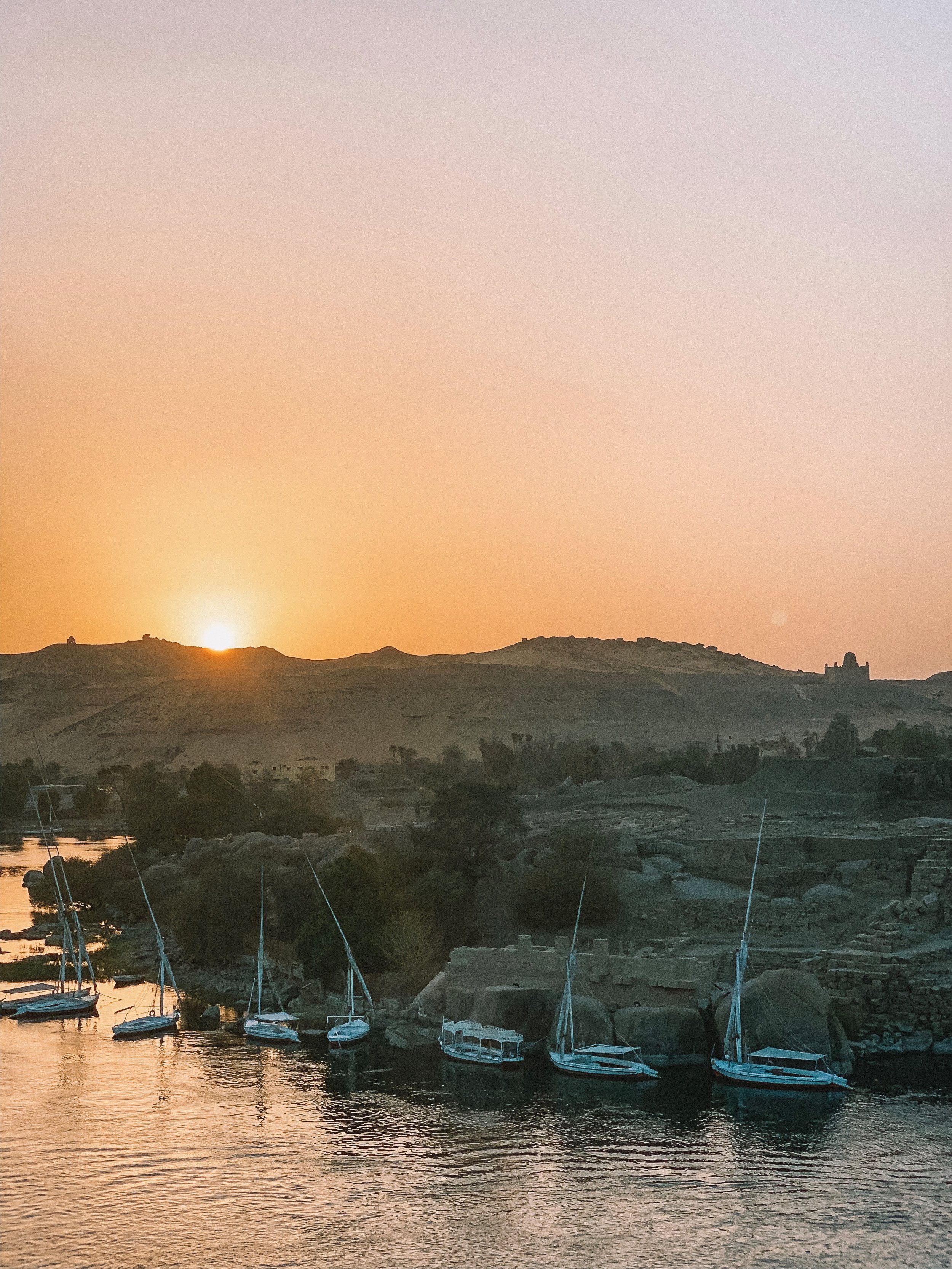Aswan & Abu Simbel – Majestic temples where the Sahara meets the Nile
It’s hard to imagine that some of Egypt’s most magnificent monuments and temples could have stood the test of time, only to be lost to the relentless advance of modernisation.
Thankfully, due to the efforts in the 1960s by international teams, 22 of these sites from Abu Simbel to Philae were saved and preserved not only to remain popular traveller pilgrimages, but symbols of human ingenuity, both ancient and new.
In Egypt’s far southern reaches lies Aswan.
Located around the ancient island of Elephantine, the region has been important since ancient times when it was the first nome (region) of Upper Egypt, the location of the First Cataract, and the beginning of the Nubian lands.
It’s a peaceful and, given its setting on the Nile, romantic town – the landscape differing from what travellers arriving from Luxor by water would have seen whilst on their journey upstream.
The lush green farmland and reeds that line the Nile north of Aswan is gradually replaced by arid land as the Sahara creeps closer to the water.
Rocky granite outcrops puncture the fast flowing Nile, creating islands and obstacles meaning only smaller feluccas or motorised boats can navigate the waters.
It’s quite beautiful to admire with a gin and tonic from your accommodation along the river – in our case this was the beautiful Sofitel Legend Old Cataract Aswan which commands a stunning position opposite the southern end of Elephantine Island with views across the river to the west where the setting sun illuminates the Mausoleum of Aga Khan.
Our main reason for spending some time – just a short single night – in Aswan following our spectacular cruise with Nour El Nil was to see the famed dual temples of Abu Simbel as well as the Temple of Isis at Philae.
There is much more to see around Aswan – the High Dam, unfinished obelisk, Elephantine Island, the Nubian Village and museum to name a few – however, we chose to just see Abu Simbel and Philae opting instead for some downtime at our hotel.
We could have seen more, but we wouldn’t have enjoyed our nice hotel and at this point, we’d seen enough over the previous almost two weeks that we were happy with our decision. If we’d had another night in Aswan, we probably would have ticked a few more monuments and attractions off the list though.
So our itinerary for Aswan ended up pretty relaxed:
Day 1: Late morning flight to Abu Simbel (returning early afternoon), relax at the hotel in the afternoon, visit Aswan souk in the evening
Day 2: Early morning visit to the Temple of Isis at Philae, relax at hotel, mid-afternoon flight to Cairo and onwards to Beirut











Abu Simbel – Absolutely fascinating temples which should be a must see on any visit to Egypt
This was the second time I cried on this trip – the first was at the Egyptian Museum in Cairo standing in front of Tutankhamun’s gold mask.
We were leaving the temples and I stopped and turned back to appreciate them one last time and was so overwhelmed.
Dreaming of seeing something like this all your life and then having the opportunity to stand in front of it really is such a magical moment and something that I’m always grateful for as I travel the world.
It’s an astonishing complex, not only because of the scale of the temples which were constructed into the rock cliffs by Ramesses II almost 3,300 years ago, but because they were cut into blocks, moved to higher ground, then reconstructed as if a Lego set for giants in the 1960s to save them from the rising waters of Lake Nasser due to the construction of the Aswan High Dam.
Not all travellers make the trip to Abu Simbel from Aswan (you’re basically at the border with Sudan when you do), but I really could not imagine visiting Egypt and leaving without seeing these iconic temples.
So, how to get there.
If staying in Aswan, you basically have two options. One involves an early start and a three hour drive to reach Abu Simbel, a couple of hours to visit, then three hours back to Aswan. The other is a 45 minute flight. There is also the option of multi-day Lake Nasser cruises.
In the interests of time – and comfort – we chose the flight.
Flying is (of course) the much more expensive option, but it suited our plans well. We departed Aswan airport at 10:10 a.m. and landed back on time at 2:00 p.m. I believe the flight continued to Cairo, so that could be an option if you wished.
One tip – book seats on the right side of the plane as you’ll be able to spot the temples as you descend for landing – it’s such an amazing view! I was in seat 21A which is the second row of business class on the small Embraer 170 that flies this route.
It’s an easy return flight from Aswan with EgyptAir Express and the whole experience is really well engineered for visitors.
The plane is basically on the ground in Abu Simbel for just over two hours, during which time you take a free shuttle from the airport to the temples (about 10 minutes, ignore all the taxi drivers at the airport telling you there is no bus or the bus is not leaving soon), have around 90 minutes at the site, then take the shuttle back to the airport and straight onto the plan.
It’s easy to do all this on your own and you definitely don’t need a guide here (and they can’t go inside the temples here anyway).
You approach the temples down a path which hides them from view until the last moment as you round the final bend at the foot of the artificial hill that was built around them after the relocation.
The Great Temple of Ramesses II immediately draws you in – the majestic façade of four gigantic, 20 metre high, statues of a seated Ramesses II is easily one of the most impressive things we saw in Egypt.
You enter the temple between the colossal statues in the centre of the façade, which was originally carved directly into the bedrock of the original location.
Inside, the temple follows a similar layout to most temples from this period of ancient Egypt. The first space you enter is the beautiful hypostyle hall with eight statues of Ramesses in the standing Osirid pose. Much of the walls in this hall are decorated with tales of military campaigns, particularly the infamous Battle of Kadesh.
From this hall, you move into a second pillared hall which has many scenes of Ramesses and his wife Nefertari making offerings to the gods. Off this hall are various decorated rooms which most likely would have been storage rooms for the temple.
Finally, 65 m into the rock from the entrance to the temple, you reach the most sacred section of the temple – the holy of holies. The temple is dedicated to the gods Amun, Ra-Horakhty and Ptah, as well as a deified Ramesses II, and their statues remain here along with the pedestal where the sacred barque would have been placed.
The temple was aligned and positioned by the ancient Egyptian architects in such a way that on 22 October and 22 February, the rays of the sun penetrate the sanctuary and illuminate the sculptures on the back wall, except for the statue of Ptah, a god connected with the Egyptian underworld, who always remained in the dark.
It really is astonishing what these people managed to do so long ago without the technology we have today!
The second temple at Abu Simbel is the Temple of Hathor, which was built in honour of Nefertari, the most favourite wife of Ramesses II.
Its beautiful façade features six statues – four of Ramesses and two of Nefertari. This was only the second temple dedicated to a queen in ancient Egypt (the first was for Nefertiri by her husband Akhenaten), and never before had a queen been depicted alongside her husband and on the same scale on the façade of a temple.
Inside, the temple follows the same layout and design as the main temple, albeit on a much smaller and more intimate scale. The hypostyle hall has beautiful Hathor-style pillars along with some stunning images of the queen which depict her obvious beauty. In the sanctuary of the temple, a high relief of Hathor depicted as a cow-goddess appears to emerge out of the mountain.
As I said, both temples are absolutely worth the trip from Aswan and I would not have been disappointed if the flight was not an option.
Do take time before leaving to stop in the small, but interesting, visitor centre which details how the temples were moved from their original location which is now lost some 60 metres below the waters of the lake.
We wandered back to meet the shuttle to take us to the airport, both completely enthralled and in awe of what we’d seen.
It wasn’t the absolute final monument we’d see in Egypt, but it felt like such a high note to finish on, particularly for me as I’d had in the back of my mind that we’d reach Abu Simbel at the end of our sojourn through the country.
Temple of Philae – Set on an island along a dramatic section of the Nile, this is possibly the most scenically located temple in all of Egypt
It was our last day in Egypt and the last place I wanted to see was the Temple of Philae, dedicated to the goddess Isis.
We decided to set off early at around 6:30 a.m. with our driver and guide. We got to the quay where you take a small boat across the Nile to the temple a little early, but once we were allowed to set off, we were the first to arrive at the temple when it opened at 7:00 a.m.
The journey on the boat across the waters in between the Aswan Low Dam and the Aswan High Dam is beautiful, particularly in the morning light.
As you approach the island the temple is located on, you are treated to a magnificent vista before landing at what would have once been the ancient quay to access the island.
The island the temple is now located on is not the original location. This is one of the temples which were saved from the rising waters and it actually spent around 50 years partially submerged before there was a massive effort to dismantle it and move it from the original Philae Island to its new location on Agilika Island.
It was reconstructed in the same orientation and Agilika was actual reshaped slightly to resemble the original island the temple was located on. The effort the teams went to during the Aswan High Dam Project when saving these monuments is just incredible.
The success of the Nubia Campaign inspired the development and adoption in 1972 of UNESCO's World Heritage Convention and the inscription of sites on UNESCO's World Heritage List on which the Nubian Monuments from Abu Simbel to Philae were inscribed in 1979.














The temple itself is from the Ptolemaic period and was the last temple built in the classical Egyptian style. There are many legends attached to the temple, one being that this is location where Isis found Osiris heart after he was killed by his brother Seth, who scattered his remains across the Egypt and surrounds.
You enter the temple through a stunning colonnaded courtyard which leads to the well decorated first pylon with its usual scenes of victory and worshiping deities.
Through the pylon you’ll find the colonnaded inner court. Of particularly interest are the columns of the birth-house which have Hathor-style capitals. There are seven in total and if you look closely, you can see the expression on the faces change from sad or neutral, to happy.
You continue deeper into the temple through the second pylon into the hypostyle hall. This hall is actually pretty underwhelming compared with other similar halls from the same period. Off this area is the main sanctuaries of the temple where you can still see the pedestal where the sacred barque and statue of Isis would have rested.
After visiting the main temple, a few smaller structures are dotted around the complex. There is the Gate of Hadrian where you can see an image of the god Hapi, who was god of the Nile.
There is a small, but delightful, Temple of Hathor which has some great reliefs of musicians – look out for the ape playing the flute – and of Bes, the god of childbirth.
The final monument is the Kiosk of Trajan, which would have once been the main entry to the temple. The distinctive structure is now missing its roof, but it’s a beautiful building with 14 grand columns. You get a fantastic view of it from the water as you head back to Aswan.
I really enjoyed our morning at Philae. It was perfect visiting early as we could really enjoy its peaceful setting – as we were leaving, the complex was really starting to fill up.
We headed back to Aswan (and back to our hotel in time for breakfast!), watching the temple slip away into the distance completely satisfied after a wonderful two weeks of exploring all these incredible ancient sites.
Aswan – Make sure you visit the souk in the evening to see a bit of local life
I don’t really have a lot to say about Aswan. Aside from our trips to Abu Simbel and Philae, we pretty much just lazed around our hotel, enjoying the pool and our suite – we had an amazing view of the Nile from our large balcony.
I think Aswan should really be given a couple of nights pre or post a Nile cruise (if that’s what you’re here for), or just in general as part of an Egypt itinerary. There does seem to be a lot to see, and it’s a slower paced, more relaxed city that Luxor and especially Cairo.
We did venture out of the hotel on the evening of our stay before dinner. I’d forgotten to get some souvenirs for my family – specifically some papyrus for my father. I’d read the Aswan souk (aka Sharia el Souk) was interesting to visit.
I was really surprised how local it was. There were barely any overly touristy shops and we weren’t hassled the way we were in Cairo and Luxor.
It was nice the see the locals in the evening going about their business in the shops and around the mosques.
I managed to find some papyrus in what I think was a more tourist-orientated area of the bazaar for a really good price (it’s probably banana leaf or something else though) and we walked back along the river to our hotel for dinner.
We had a great couple of days in Aswan, and I’ll definitely include a couple of nights here when I go back to Egypt – I really recommend the Sofitel Legend Old Cataract Aswan. It’s a fantastic property and a really luxurious place to spend a couple of relaxing days.



















